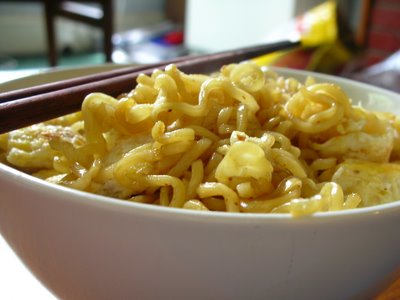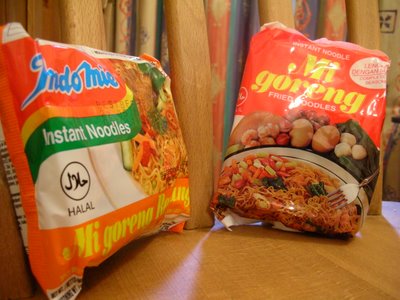To me, the perfect Indomie has glinting gold strands, speckled with red, with nuggets of creamy yellow egg. Behold! Perfection ... in a bowl!

The development of the perfect indomie is not something that comes about, just like that! For me, the journey took almost the whole of my life (so far)! Each phase of my life almost exactly corresponds with a new version of indomie. Hence, the story of my indomie journey... is the story of my life! ;)
Childhood
When we were children, we ate Indomie Talur (Indomie with Egg) where the cooked indomie noodles were mixed in with beaten egg and ABC sweet soy sauce, then fried. Very little of the seasoning was used, with the egg and soy sauce providing most of the flavour. This resulted in a sticky dark brown indomie, all coated in egg. Ibu confessed that the reason she fed us this was to give us something "more" to eat than just plain indomie. Back in those days, a single indomie would keep us satiated for the whole day, so it was pretty important to give us at least *some* nutrition, as we would eat nothing else.
Teenage Years
As we got more adventurous in trying food, got increasingly prodigious appetites and started cooking for ourselves, new versions of indomie cropped up left and right. Each was usually named after their creator. Sadly, I DON'T HAVE A VERSION NAMED AFTER ME.... as I never invented a new version :(
Hadi's Indomie, later known as just Indomie
As we started to read the back of the Indomie packet, we realised that there was another way of cooking the Indomie. Hadi's Indomie was the result of this - follow the instructions on the packet all the way through. Eventually, an egg omelet was added, to be eaten with the Indomie.
Syukri's Indomie
The noodles are cooked as usual, but instead of adding the seasonings straight, the oil packet is heated in the saucepan and the onions in it fried briefly. Then, the noodles and other seasonings were added, mixed well and heated briefly before eating. Syukri never adds the chilli powder though, and his eggs are usually scrambled.
Aunty Yeni's Indomie
This is more of a combination of Hadi and Syukri's Indomies. Its cooked according to the packet, and all the seasonings added, but before eating, you fry it briefly to dry up the noodles. This concentrates the flavour tremendously, but has the side-effect of dry noodles.
The indomie of our childhood was then renamed to Hanisah's Indomie - since she was the only one who ate it regularly.
University
(GAH! I am no longer a teenager! D:)
In my first year of university, my cooking repertoire was limited (unlike now! ahahaha) Hence, Indomie featured greatly in my meals and I was able to modify a little here, a little there, to come up with an Indomie that, to me, is absolutely perfect! Its further optimised to reduce washing (malas bah!) and to keep it warmer longer (absolutely necessary in the cold UK weather!).
- Cook scrambled eggs in a non-stick saucepan (oil not necassary, if not non-stick, add oil), seasoning well with salt and white pepper. Set aside in a small bowl.
- In the same pan, cook the noodles in boiling water until just tender. It should just be just firm enough to lose the crunchiness, but not too soft that it loses its curliness, if you know what I mean :P Too soft noodles have too large a surface area, which dilutes the flavour. Ahahaha, a scientific explanation!
- Drain the noodles and switch off the heat. Replace the noodles in the now empty saucepan and place the saucepan on the (still hot, i hope!) stove surface. Add all the seasonings, mix well. The indomie should be sizzling slightly, but not too much. Add the eggs, mix well, place in the bowl the eggs were in and eat immediately!
Its a commonly held opinion that Indomie is better cooked in small batches, one packet at a time, if possible. I agree. With two or more packets, its really hard to mix the Indomie well and it doesn't turn out as flavoursome. ;)
Recently, Hadi looked up Indomie on Wikipedia and they suggested "curing" your Indomie. Here's an excerpt:
It has been reputed that allowing cooked Mi Goreng to 'cure' in the refrigerator overnight allows the fats to solidify and absorb greater amounts of taste. On reheating, the flavours combine completely resulting in a flavour explosion. It is suggested that leaving the noodles to cure uncovered allows some dehydration to occur which further concentrates the taste. This phenomenon is rare, as most are predisposed to consume their Mi Goreng as soon as it is prepared.
Well, he tried that out and we both tasted it. We failed to taste the "flavour explosion" mentioned. In fact, the Indomie tasted less flavoursome! So I would suggest you steer clear of this method ;) The Wiki article, however, does have some interesting bits about Indomie, particularly the ones they export outside
 SE Asia. Here in UK, we have different flavours, as well as a nutrition table! The packet is slightly different as well, but its exactly the same as the OLD-style indomie (vertical packet), which has a dry packet and wet packet only. Read the Wiki article, it'll make more sense :P
SE Asia. Here in UK, we have different flavours, as well as a nutrition table! The packet is slightly different as well, but its exactly the same as the OLD-style indomie (vertical packet), which has a dry packet and wet packet only. Read the Wiki article, it'll make more sense :PBut, as always, different people have different tastes, so your perfect Indomie might not be MY perfect Indomie ;) So... good luck in YOUR journey in finding out what exactly constitutes your very own "Perfect Indomie".
Quote of the day: One man's meat is another man's poison.
MiGoreng is like MY MOST FAVOURITE all time staple but I quit it for almost 2 months for health reasons.
ReplyDeleteTwo mths ! That's a record for me to be honest.
I love it as well! But yeah, its not very healthy :P I used to eat about 2 packs per week, but here in the UK, we have to ration it some more :P SOOOO expensive here!
ReplyDeleteBack in Brunei in my younger days, I can almost eat 2-3 packets daily. I hope I din do too much damage to my poor body.
ReplyDeleteFor a truly complete and perfect experience, add tuna. Further to this, instead of using the oil that comes with the Indomie, use tuna in oil (healthier oil..) which even tastes better too.
ReplyDeleteProcedure is as follows:
1) cook noodles as described in article, to the point that they are no longer crunchy but not over-cooked.
2) while noodles are cooking mix seasoning, sambal and kecap in a bowl
3) drain noodles, add to bowl and mix
4) cook egg, preferably preserving yolk so that it is runny and can later be mixed in with noodles.
5) mix tuna in with noodles, top with fried onion and egg
6) enjoy!
Thanks for the tip, G! Unfortunately, I'm not really a fan of tuna, but your "recipe" sounds really good. I'm sure that my brother (and one of my sisters, even) would enjoy it. I'll tip them off next time, hehe.
ReplyDeleteAs a college student I eat indomie ALL the time... so good. I make what I call "double indomie" for lunch a lot of the time, that keeps me full for hours!
ReplyDelete1 - boil 2 pkts of noodles, then drain
2 - using a little veg oil, fry the noodles and mix all the spice packets (sans 1 chili pack if you can't stand too much spice like me). Fry until just slightly crispy, then transfer to bowl.
3 - fry one or two eggs sunny side up, making absolutely sure not to break the yolks and to cook the whites thoroughly.
4 - carefully place the eggs on top, sprinkle with more fried onion, then break the yolks with your fork and watch the yummy golden goodness drizzle over the noodles.